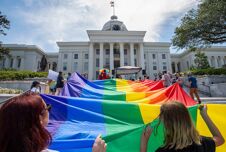LGBTQ+ parents have existed for as long as LGBTQ+ people have been around. That is to say, forever.
We haven’t been visible until recent decades and haven’t had any rights until recent years, but we have been here. We have been able to have biological children as bisexual and transgender parents, as well as lesbian and gay parents (from various situations, including relationships before coming out). Before there were any legal rights, we’ve had step-children and children in different configurations of chosen family. And now, we can legally adopt and foster in every state.
Related:
LGBTQ+ couples forced to crowdfund paths to parenthood as insurance discriminates
One gay male couple’s insurance company denied them coverage since. technically. they could successfully conceive with women.
But it’s been a long road to get here, and we still don’t have equality.
Never Miss a Beat
Subscribe to our newsletter to stay ahead of the latest LGBTQ+ political news and insights.
A brief history of queer parenthood
We know that queer people have existed all through history, so it’s not a stretch to imagine we’ve parented from ancient times, though the records don’t exist. In recent centuries, Oscar Wilde (1854-1900)’s wife forced him to give up parental rights to their two sons after the indecency trials for his queerness. Audre Lorde (1934-1992) was proudly lesbian, but before she was with her female life partner for over 20 years, she had two children with an out gay husband. Bisexual icon Josephine Baker (1906-1975) adopted twelve children from nine countries and cited being too busy with motherhood as her reason for turning down Coretta Scott King’s offer to become a new figurehead of the Civil Rights Movement after Dr. Martin Luther King’s assassination.
Other queer historical figures had children within their straight-passing marriages, like Eleanor Roosevelt (1884-1962) and Abraham Lincoln (1809-1865). In one story of a documented transgender parent, American jazz musician Billy Tipton (1914-1989) adopted three children with one of his wives. The adoptions and the marriage weren’t legally recognized, and according to all five women who married him at different times and all three children, none of them knew of his trans identity until he passed away.
Wilde’s loss of custody and the lack of legal recognition over Tipton’s adopted children are indicative of the landscape of LGBTQ+ parentage rights in the 19th and 20th centuries. In cases documented as early as the 1950s in the U.S, a parent’s homosexuality was routinely used to take away custody of their children in a divorce because it was considered a mental illness to be gay or transgender. One mother lost custody because she “associated with female homosexuals and refused to change her ways.” In another, a wife’s “strange passions” made her an “unfit mother.” In another, a judge decided that a heterosexual environment was in “the best interests of the child.”
In the mid-1950s, the nation’s first lesbian rights organization, the Daughters of Bilitis, held the first known official discussion groups about lesbian motherhood. Group co-founder Del Martin (1921-2008) was divorced from a husband before her 50-year partnership with Phyllis Lyon (1924-2020), which was foundational to the lesbian rights movement.
Martin’s ex-husband retained primary custody of their daughter, Kendra. Martin went on to co-found another group, the Lesbian Mothers Union, with Pat Norman and others in 1971 in California. Chapters popped up around the country throughout the 1970s. The group helped lesbian mothers in their custody battles by raising legal fees, putting them in touch with sympathetic witnesses, and trying to change the perception of lesbians as deviants who could not provide a moral home for children.
The movement for queer women to start inseminations from sperm donors grew in the 1970s. Because clinics only served married women, they had to find sperm donors outside of fertility clinics by using friends, helpful queer men, or strangers (the Sperm Bank of California became the first in the country in 1982 to serve single people and queer women). On top of that, there were no legal protections against the donors claiming parental rights, and the co-parents who didn’t give birth had no legal claim to their child.
Adoption also started to become an option in a few areas around that time. In 1978, New York became the first state not to reject applications for adoption based on sexual orientation. One year later, a gay couple in California became the first same-sex couple to jointly adopt a child. A single gay man had already adopted a child in California in 1968.
The 1970s began a positive turning point in custody cases, with openly LGBTQ+ parents winning for the first time. In 1973, a transgender parent won his right to retain custody of his child in Colorado, the first known court opinion involving a trans parent. In 1974, a New Jersey court affirmed that a gay father’s sexual orientation was not a reason to deny him child visitation. It was the first time a U.S. court acknowledged the constitutional rights of LGBTQ+ parents. In 1976, Washington, D.C. became the first jurisdiction in the country to prohibit judges from making custody decisions based solely on sexual orientation.
With self-inseminations and the growth of visibility of the LGBTQ+ rights movement, the “gayby boom” began. The term appeared in print in a story in Newsweek in 1990. It noted that the AIDS epidemic was the top issue for the LGBTQ+ community, but that family issues like child custody and marriage equality were starting to be added to the agenda.
It goes on: “Many are already living the settled-down life of their ‘breeder’ peers. That includes children–either through adoption, artificial insemination or arrangements between lesbians and gay ‘uncles.’ There are an estimated 3 million to 5 million lesbian and gay parents who have had children in the context of a heterosexual relationship. But in the San Francisco area alone, at least 1,000 children have been born to gay or lesbian couples in the last five years.”
The children’s books Heather Has Two Mommies and Daddy’s Roommate came out in 1989 and 1990, adding to the visibility of LGBTQ+ families.
Transgender men’s pregnancies started to make the news as sensationalist headlines in the 2000s, but today the field of trans fertility is growing with studies, trainings, and resources.
When marriage equality isn’t enough
Around the turn of the century, civil unions began popping up, then marriage state by state until there was federal recognition of these marriages in 2013. And finally, the Supreme Court granted national same-sex marriage rights in 2015. These relationship protections helped couples with children achieve legal rights for both parents. But it wasn’t automatic. National LGBTQ+ legal organizations still advise that a birth certificate is not enough to prove parentage or custody and recommend that non-biological parents go through a second-parent adoption as they did before marriage legalization.
Earlier this year, for example, an Oklahoma judge ruled that a nongestational mother who was on her child’s birth certificate, married to the child’s other mother, co-created the child, co-raised the child from birth, and had given the child her last name had no parental rights to the child — but the sperm donor did as the biological father.
“LGBTQ+ parents and our children are most definitely under attack, both as part of the general attacks on LGBTQ+ people right now and in terms of specific attacks on our families,” says Dana Rudolph, founder and publisher of the two-time GLAAD Media Award-winning site, Mombian and creator of LGBTQ Families Day.
She doesn’t see this as a moment of losing rights, but rather as ongoing inequality, since full equality for LGBTQ+ parents has never been reached.
“LGBTQ+ parents and our children have more visibility than ever, in our communities and workplaces, in the news, and in books and other media for children,” Rudolph says. “Despite current attacks on our families in many places, I think that broadly speaking, we have achieved greater acceptance over the past decades, making it easier to be visible.”
Nevertheless, bans of books showing LGBTQ+ families, state laws allowing discrimination against LGBTQ+ people in adoption and foster care, anti-trans laws, and outdated state parentage laws, all leave LGBTQ+ parents at risk.
But LGBTQ+ parents’ numbers are growing. One in three LGBTQ+ people has had a child at some point in their life and as many as six million Americans have an LGBTQ+ parent. Half of LGBTQ+ millennials are actively planning on having a first or additional child. And there are many famous LGBTQ+ parents today – including Lance Bass, Karamo Brown, Andy Cohen, Anderson Cooper, Elton John, Melissa Etheridge, Tan France, Miss Major Griffin-Gracy, Patrick Harris & David Burtka, Jesse Tyler Ferguson & Justin Mikita, Ricky Martin, and Wanda Sykes – who are doing wonders for visibility.
They all stand on the shoulders of the parents who came before and fought for the rights we have today to be able to adopt, appear on birth certificates, partner with surrogates, get married, and more. Today, we’re more visible and protected than ever today, even if we still have further to go.














